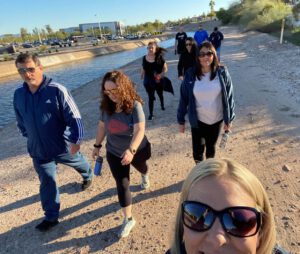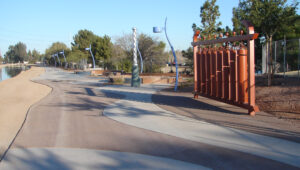The Salt River Project (SRP) has 131 miles of canals in the Phoenix, Arizona, area, 60 miles of which have public recreational paths alongside them. This year, a group of 23 SRP employees have committed to walk all 131 miles of the canal system, calling their project 131 Can Be Done. In addition to being a healthy challenge, 131 Can Be Done is helping office staff connect with field teams and learn more about how the SRP canal system works on a dayto-day basis.
In this interview, Lynn Allen, the manager of the SRP Water Contact Center, and Stephanie Berry, SRP’s manager of water scheduling and field customer service, tell Municipal Water Leader about their experiences walking SRP’s canals and how it has informed their work.
Municipal Water Leader: Please tell us about your backgrounds and how you came to be in your current positions.
Lynn Allen: I’ve been with SRP for a little over 18 years. I started in the Residential Contact Center and then moved to a variety of different positions within SRP. I worked in community outreach, financial services, and information
technology and then moved back to customer service. Now I’m the manager of the Water Contact Center.
Stephanie Berry: I’ve been with SRP for just over 20 years. I started on the power side in the Residential Contact Center. I have worked in a few other divisions, including outage management; M-Power operations, our prepaid electric department; and customer accounting. I moved to water scheduling and subdivision services last year.
Municipal Water Leader: What is the Water Contact Center?

Lynn Allen: It is a 24/7 customer contact center that provides the ultimate customer experience to our water customers. We handle calls from water stakeholders, the general public, and SRP personnel. We perform a variety of functions, including placing water orders, processing water payments, advising customers of their scheduled water delivery times, assisting with water issues, and scheduling customer education training meetings.
Municipal Water Leader: Please tell us about SRP’s canal system.
Stephanie Berry: SRP has been delivering water to the valley since 1903. Our system consists of dams, lakes, and rivers, which eventually deliver water into seven main canals totaling 131 miles in length. Most of us mentally relate irrigation to farms, and that is how it all started. However, as the valley has changed, so have irrigation needs. SRP delivers irrigation water to large commercial farms, small private farms, dairies, city lakes, parks and schools, golf courses, urban farm co-ops, and residential subdivisions.
Municipal Water Leader: Of those 131 miles, how much of the canals have trails alongside them?
Lynn Allen: 60 miles.
Municipal Water Leader: What are some of the main recreational activities that people do along the canals?
Stephanie Berry: A lot of walking, bike riding, and rollerskating. A lot of people use the canal path to commute to the nearby community colleges. The City of Scottsdale also uses the canal front for a festival called Canal Convergence that involves art, food, and vendors.
Municipal Water Leader: What was the motivation for starting the 131 Can Be Done project?
Stephanie Berry: Lynn and I are fairly new to water services—I’ve been here about a year and Lynn is a couple of months in—and we recently went to a presentation at which an SRP employee talked about the 131 miles of canal in the SRP system. Lynn said, half-joking at first, that we should walk those 131 miles to learn more about the system and its history. We could take along the people who have been working at SRP for 30–40 years and learn from them. I said, “Sure, let’s do it.” Then the next thing you know, it became a reality.
Municipal Water Leader: How many people have taken part so far?
Lynn Allen: There are 23 people on the team. Three are from media relations; everybody else is from water services. We go out once a week as a team and walk 3 miles. Now that the weather is picking up and temperatures are increasing, we’re going to start biking the canals in the early mornings. Our goal is to bike 5–8 miles a week.
Municipal Water Leader: What have you learned along the way?
Lynn Allen: We’ve learned a lot along the way, thanks to our peer, Don Lane, who manages the water masters and zanjeros. Don and his department are part of our walking team, and they teach us about the seven different canals that SRP manages. The canals are all a little bit different. Some connect to private systems, some to laterals. It’s been a great experience to see the full end-to-end process, which is something that we don’t necessarily see from the office.
Municipal Water Leader: What have you learned about the history of the canal?
Stephanie Berry: We’ve walked a couple of sections in Mesa near Mesa Country Club that we learned were built by a farmer named Dr. Alexander Chandler, who founded the community of Chandler, Arizona, in 1912. You would never know that this stretch of the canal was built by a member of the community to bring water to his farm. The rest of the community benefited from it, and eventually, SRP took over the operation.
Municipal Water Leader: Are there any other interesting or unexpected things that you’ve come across in the course of the project?
Stephanie Berry: We saw an interesting contraption along one of the canals that looked like a chair on a lift that slides across the canal. It was used historically to measure the depth of the canal.

It has also been a learning experience. My team schedules the water based on customer need and decides when and where the zanjeros need to turn the gates on or off to ensure efficient and on-time deliveries. Besides that, we are field service liaisons, meaning we go out into the community and solve issues between neighbors and educate people about how the irrigation systems work. It has been helpful to be out there and actually see the zanjeros working hard to meet customer demands. Water masters will explain to us how hard it can be to get from one canal to the other canal if there’s construction or a marathon in the way. This information helps us explain to customers why we can’t always be there the second they need us. We’ve learned more in the last couple of weeks of walking than we could have from a book.
Lynn Allen: It has also given us the opportunity to build relationships with the field crews and to learn what they go through every day.
Municipal Water Leader: Have you changed your operations at all in response to what you’ve learned?
Lynn Allen: Definitely. We haven’t changed any major processes, but it has helped us think of innovative ideas and customer-focused solutions. We’re taking into account what the zanjeros and water masters are doing each day to meet customer needs while providing a safe working environment for both our customers and employees. It’s definitely helped bring the different departments of SRP together, which is important for meeting the needs of our customers. By going on these weekly walks along the canal, we’re able to fill the gaps in our understanding of our business processes and customer expectations by seeing things in person that we previously only knew about on paper.
Municipal Water Leader: Has this functioned as a community outreach tool as well?
Lynn Allen: A little bit. A couple of SRP retirees have our map and schedule, and they’ve been walking or biking
the canals on their own time and reporting what they’ve completed. For now, this is an internal SRP education and exercise effort. If the community would like to join, they’re more than welcome to use our online canal maps to plan and track their routes and progress. Once we get through this first year, we hope to expand this into something bigger that would involve the community. It’s great to stress to the community that the canal paths are available. It amazes me every time I’m out there to see how many people use the canal paths to walk their pets, exercise, or walk with their families and friends. It’s a great opportunity to learn about SRP’s canals and all the great features we have while exercising and enjoying the beautiful Arizona weather.
Lynn Allen is the manager of the SRP Water Contact Center. She can be contacted at lynn.allen@srpnet.com.
Stephanie Berry is the manager of water scheduling and subdivision services at SRP. She can be contacted at stephanie.berry@srpnet.com.
For more information about SRP’s irrigation services, visit srpnet.com/menu/water/ irrigation.aspx.
